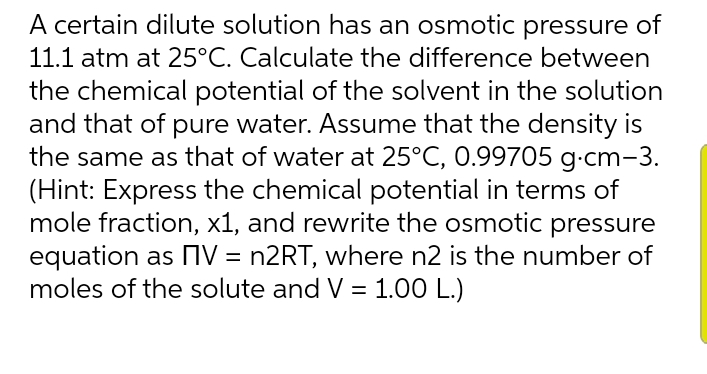A certain dilute solution has an osmotic pressure of 11.1 atm at 25°C. Calculate the difference between the chemical potential of the solvent in the solution and that of pure water. Assume that the density is the same as that of water at 25°C, 0.99705 g-cm-3. (Hint: Express the chemical potential in terms of mole fraction, x1, and rewrite the osmotic pressure equation as NV = n2RT, where n2 is the number of moles of the solute and V = 1.00 L.) %3D
A certain dilute solution has an osmotic pressure of 11.1 atm at 25°C. Calculate the difference between the chemical potential of the solvent in the solution and that of pure water. Assume that the density is the same as that of water at 25°C, 0.99705 g-cm-3. (Hint: Express the chemical potential in terms of mole fraction, x1, and rewrite the osmotic pressure equation as NV = n2RT, where n2 is the number of moles of the solute and V = 1.00 L.) %3D
Chemistry & Chemical Reactivity
9th Edition
ISBN:9781133949640
Author:John C. Kotz, Paul M. Treichel, John Townsend, David Treichel
Publisher:John C. Kotz, Paul M. Treichel, John Townsend, David Treichel
Chapter13: Solutions And Their Behavior
Section: Chapter Questions
Problem 1PS: You dissolve 2.56 g of succinic acid, C2H4(CO2H)2, in 500. mL of water. Assuming that the density of...
Related questions
Question

Transcribed Image Text:A certain dilute solution has an osmotic pressure of
11.1 atm at 25°C. Calculate the difference between
the chemical potential of the solvent in the solution
and that of pure water. Assume that the density is
the same as that of water at 25°C, 0.99705 g-cm-3.
(Hint: Express the chemical potential in terms of
mole fraction, x1, and rewrite the osmotic pressure
equation as OV = n2RT, where n2 is the number of
moles of the solute and V = 1.00 L.)
Expert Solution
This question has been solved!
Explore an expertly crafted, step-by-step solution for a thorough understanding of key concepts.
This is a popular solution!
Trending now
This is a popular solution!
Step by step
Solved in 2 steps with 2 images

Knowledge Booster
Learn more about
Need a deep-dive on the concept behind this application? Look no further. Learn more about this topic, chemistry and related others by exploring similar questions and additional content below.Recommended textbooks for you

Chemistry & Chemical Reactivity
Chemistry
ISBN:
9781133949640
Author:
John C. Kotz, Paul M. Treichel, John Townsend, David Treichel
Publisher:
Cengage Learning

Chemistry & Chemical Reactivity
Chemistry
ISBN:
9781337399074
Author:
John C. Kotz, Paul M. Treichel, John Townsend, David Treichel
Publisher:
Cengage Learning

Chemistry: The Molecular Science
Chemistry
ISBN:
9781285199047
Author:
John W. Moore, Conrad L. Stanitski
Publisher:
Cengage Learning

Chemistry & Chemical Reactivity
Chemistry
ISBN:
9781133949640
Author:
John C. Kotz, Paul M. Treichel, John Townsend, David Treichel
Publisher:
Cengage Learning

Chemistry & Chemical Reactivity
Chemistry
ISBN:
9781337399074
Author:
John C. Kotz, Paul M. Treichel, John Townsend, David Treichel
Publisher:
Cengage Learning

Chemistry: The Molecular Science
Chemistry
ISBN:
9781285199047
Author:
John W. Moore, Conrad L. Stanitski
Publisher:
Cengage Learning

Chemistry
Chemistry
ISBN:
9781305957404
Author:
Steven S. Zumdahl, Susan A. Zumdahl, Donald J. DeCoste
Publisher:
Cengage Learning


Chemistry: An Atoms First Approach
Chemistry
ISBN:
9781305079243
Author:
Steven S. Zumdahl, Susan A. Zumdahl
Publisher:
Cengage Learning